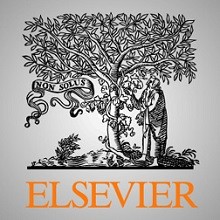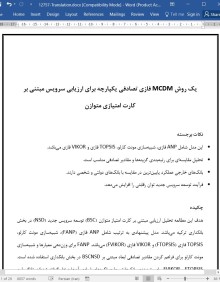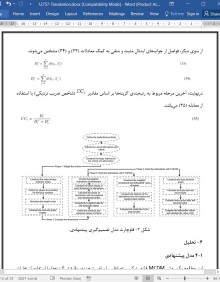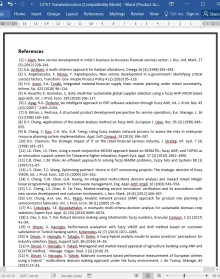
دانلود مقاله یک روش MCDM فازی تصادفی یکپارچه برای ارزیابی سرویس مبتنی بر کارت امتیازی متوازن
چکیده
هدف این مطالعه تحلیل ارزیابی مبتنی بر کارت امتیاز متوازن (BSC) توسعه سرویس جدید (NSD) در بخش بانکداری ترکیه می باشد. مدل پیشنهادی به ترتیب شامل ANP فازی (FANP)، شبیه سازی مونت کارلو، TOPSIS فازی (FTOPSIS) و VIKOR فازی (FVIKOR) می باشد. FANP برای وزن دهی معیارها و شبیه سازی مونت کارلو برای فراهم کردن مقادیر تصادفی ابعاد مبتنی بر BSCNSD در بخش بانکداری استفاده شده است. FTOPSIS و FVIKOR برای رتبه بندی بانک ها توسط عملکردهای ابعادی آن ها درنظر گرفته شده اند. تازگی این مطالعه فراهم کردن یک مدل به ترتیب شامل FANP، FTOPSIS، FVIKOR و شبیه سازی مونت کارلو می باشد. اضافتا، تحلیل مبتنی بر BSCNSD برای ارزیابی بخش بانکداری ترکیه استفاده شده است. نتایج نشان می دهند که تحلیل مقایسه ای برای رتبه بندی گزینه ها و مقادیر تصادفی برای تسهیل به دست آوردن ارزیابی های کارشناسانه بسیار خوب تحت محیط فازی مناسب است. فهمیده می شود که عملکرد بانک های خارجی پایین تر از بانک های خصوصی و دولتی می باشد. ازاین رو، می توان گفت که به ویژه بانک های خارجی باید سرویس های جدیدی را برای جذب توجه مشتریان خودشان فراهم کنند. در این چارچوب، انتظارات مشتری باید توسط انجام یک تحلیل دقیق مشخص شود. در نتیجه، افزایش مزیت تفضیلی در مقایسه با بانک های دیگر می تواند امکان پذیر باشد.
1- مقدمه
با جهانی شدن، استفاده از دانش شرکت های چندملیتی را کارآمد می کند و نظارت بر سیاست های رقابتی در تعیین راهکار شامل اطلاعات تطبیق پذیر در بخش تولید و خدمات را آسان می کند. با توجه به استفاده موثر از اطلاعات، شرکت ها فرصت هایی برای تعیین صلاحیت سرویس و تولیدات در فرآیند تجاری سازی دارند. براین-اساس، سیستم مبتنی بر دانش که اقتصاد جدید نامیده می شود استفاده از داد ه های چندوجهی به دست آمده از مشتریان و مشترکان دیگر در آغاز دهه 1990 را برای شرکت های جهانی شده فراهم کرده است.
به علاوه، سهولت دستیابی به فناوری های اطلاعات و ارتباطات با اقتصاد جدید اهمیت تحلیل داده های محیطی داخلی و خارجی موجود در نوآوری تدریجی و بنیادی و فرآیند توسعه را افزایش داده است. در محیط رقابتی افزایشی، فرآیند های توسعه تولید شروع به میزبانی از فرآیندهای توسعه سرویس از دهه 1980 کرده اند. بنابراین، فرآیند اقتصاد جدید بر یک پیشرفت قابل توجه برای هر مرحله از فرآیند NSD از طراحی تا تجاری سازی در شیوه تعاملی تاکید دارد.
بطور مشابه، ارزیابی چندبعدی راهبردها و تصمیمات ابتکاری در NSD در صنعت خدمات یک موضوع جدید در محیط بازار رقابتی می باشد. عوامل حیاتی موفقیت تفکر خدماتی نوآورانه در فرمول بندی فرآیند مدیریت راهبردی و مدیریت دانش تعریف می شوند [3]. چندین عامل مانند راهکار، فرآیند توسعه رسمی شده، تیم های توسعه یکپارچه، و تعامل مشتری نزدیکی زیادی با بررسی عوامل راهبردی کلیدی در توسعه سرویس های جدید دارند [28].
5- بحث و نتیجه گیری
سیستم مبتنی بر دانش فرصت های بیشتری را به شرکت های جهانی شده در محیط بازار رقابتی ناشی از داده های چندوجهی ممکن می دهد. بیانیه های مبتنی بر بازار جدید رقیبان را مجبور به تصمیم گیری های دقیق تر می کنند. مخصوصا، تولید داده و ارزیابی آن موضوع جدیدی را در تصمیم گیری تحت شرایط غیرقطعی بوجود آورده است. به این دلیل، راهبردهای نوآورانه در مدیریت خدمات و تولید و ارزیابی های چندبعدی جدید از بازار رقابتی مولفه-های کلیدی عملیات تجاری موفق می باشند. براین اساس، ارزیابی چندبعدی راهبردهای نوآورانه، عوامل موفقیت حیاتی تفکر خدمات نوآورانه [3]، فرآیند توسعه رسمی شده بر اساس تعامل مشتری [28]، نقش نوآوری [33]، بازیگران متقابل [47،52]، و مقبولیت بازار [1،42] شواهد روشنی از اندازه گیری عملکرد چندبعدی شرکت های خدماتی می باشند.
راهبردهای نوآورانه بر اساس سیاست های چندوجهی شامل یک مجموعه از عوامل مانند شایستگی سازمانی [76،78]، یکپارچگی عوامل خارجی ]35]، انتظارات مشتری [15]، برآوردهای مالی [21] می باشند. بنابراین، سیاست های ابتکاری پویا به سمت فرآیند توسعه خدمات به ارزیابی های چندبعدی از نوآوری های خدمات تحت محیط بازار رقابتی احتیاج دارد. براین اساس، روش BSC چشم اندازهای اصلی عملکرد، مشتری، سازمان، رقابت را فراهم می کند [44،45،77] و می توان از آن برای ارزیابی عملکرد توسعه خدمات بطور چندبعدی استفاده کرد.
Abstract
The purpose of the study is to analyse the balanced scorecard (BSC)-based evaluation of the new service development (NSD) in Turkish banking sector. The proposed model includes fuzzy ANP (FANP), Monte Carlo Simulation, fuzzy TOPSIS (FTOPSIS), and fuzzy VIKOR (FVIKOR) respectively. FANP has been used for weighting the criteria, Monte Carlo Simulation has been applied to provide the stochastic values of BSC-based dimensions of NSD in banking sector. FTOPSIS and FVIKOR have been considered to rank the banks by their dimension performances. The novelty of the study is to provide an integrated model including FANP, FTOPSIS, FVIKOR, and Monte Carlo Simulation respectively. Additionally, BSC-based analysis of NSD has been applied for evaluating Turkish banking sector. The results demonstrate that the comparative analysis is coherent for ranking the alternatives and the stochastic values facilitate to obtain the immense expert evaluations under the fuzzy environment. It is identified that the performance of the foreign banks is lower than private and state banks. Hence, it can be said that especially foreign banks should develop new services to attract the attention of their customers. Within this framework, customer expectations should be defined by conducting a detailed analysis. As a result, it can be possible to increase comparative advantage in comparison with the other banks.
1. Introduction
By the globalization, the use of knowledge makes the multinational firms efficient and it eases to monitor the competitive policies in determining strategy includes versatile information for the production and service sector. Due to the effective use of information, the companies have some opportunities to determine the adequacy of the service and products in the commercialization process. Accordingly, knowledge-based system which is called the new economy has allowed the globalized firms to use the multifaced data obtained from the customers and other participants by the beginning of the 1990s.
Moreover, ease of reaching the information and communication technologies with the new economy has enhanced the importance of analysing the existing internal and external environmental data in the incremental and radical innovation and development process. In the increasing competitive environment, the product development processes have begun to host the service development processes by the 1980s. Thus, the new economic process to emphasize a sustainable progress for each stage of the NSD process from the design to the commercialization in the interactive way.
Similarly, multidimensional assessment of innovative strategies and decisions on the NSD in the service industry is a novel issue in the competitive market environment. The critical success factors of innovative service thinking are defined in the strategy and knowledge management, process formulation [3]. Several factors such as strategy, formalized development process, integrated development teams, and customer interaction are highly related to examine the key strategic factors in developing new services [28].
5. Discussion and conclusions
Knowledge-based system gives more opportunities to the globalized firms in the competitive market environment due to the possible multifaced data. New market-based statements force to the rivals for making decisions more accurately. Especially, generating the data and its evaluation arise as a novel issue to make a decision under the uncertain conditions. For this reason, innovative strategies on the service and product management and new multidimensional evaluations of competitive market are key components of successful business operations. Accordingly, the multidimensional assessment of innovative strategies, the critical success factors of innovative service thinking [3], formalized development process based on customer interaction [28], the role of innovation [33], interactive actors [47,52], and market compliance [1,42] are clear evidences of the multidimensional performance measurement of service firms.
Innovation strategies based on multifaced policies include a set of factors such as the organizational competency [76,78], integration of external factors [35], customer expectations [15], financial evaluations[21]. Thus, the dynamic innovation policies towards the service development process need the multidimensional evaluations of service innovations under the competitive market environment. Accordingly, the BSC method provides the main perspectives of performance, customer, organization, competition [44,45,77] and could be adapted to evaluate the service development performance multidimensionally.
چکیده
1- مقدمه
2- پیشینه پژوهش
3- روش
3-1 روش تصادفی برای مدل تصمیم گیری چندمعیاره
3-2 FANP
3-3 FVIKOR
3-4 FTOPSIS
4- تحلیل
1-4 مدل پیشنهادی
4-2 نتایج
5- بحث و نتیجه گیری
منابع
Abstract
1. Introduction
2. Literature review
3. Methodology
3.1. Stochastic approach to the multi-criteria decision-making model
3.2. FANP
3.3. FVIKOR
3.4. FTOPSIS
4. Analysis
4.1. Proposed model
4.2. Results
5. Discussion and conclusions
References
- ترجمه فارسی مقاله با فرمت ورد (word) با قابلیت ویرایش، بدون آرم سایت ای ترجمه
- ترجمه فارسی مقاله با فرمت pdf، بدون آرم سایت ای ترجمه



